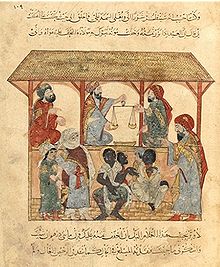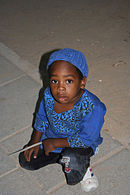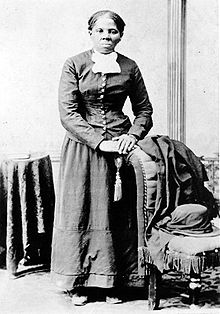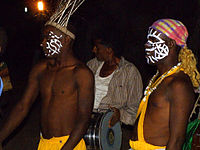- Black people
-
"Black man" redirects here. For the novel, see Black Man.
Race Classification Genetics Group differences Cross-race effect
History race and intelligence
Race and crime (US, UK)
Race and health
Race and intelligence
Race and sportsSocial Related Ethnic group
Category: Race
Genetics
Human evolution
Racism topicsThe term black people is used in systems of racial classification for humans of a dark skinned phenotype, relative to other racial groups.
Different societies apply different criteria regarding who is classified as "black", and often social variables such as class, socio-economic status also plays a role so that relatively dark-skinned people can be classified as white if they fulfill other social criteria of whiteness and relatively light-skinned people can be classified as black if they fulfill the social criteria for blackness.[1]
As a biological phenotype being "black" is often associated with the very dark skin colors of some people who are classified as 'black'. But, particularly in the United States, the racial or ethnic classification also refers to people with all possible kinds of skin pigmentation from the darkest through to the very lightest skin colors, including albinos, if they are believed by others to to have African ancestry and to exhibit cultural traits associated with being "African-American". The term 'black people' is not an indicator of skin color but of socially based racial classification.[2]
Some definitions of the term include only people of relatively recent Sub Saharan African descent (see African diaspora). Among the members of this group, dark skin is most often accompanied by the expression of natural afro-hair texture (recent scientific study notes that human skin color diversity is highest in sub-Saharan African populations).[3] Other definitions of the term "black people" extend to other populations characterized by dark skin, sometimes including people indigenous to Oceania.[4][5]
Contents
Physiological traits
Dark skin
Further information: Human skin color Map of indigenous skin color distribution in the world based on Von Luschan's chromatic scale.
Map of indigenous skin color distribution in the world based on Von Luschan's chromatic scale.
The evolution of dark skin is linked intrinsically to the loss of body hair in humans. By 1.2 million years ago, all people having descendants today had the same receptor protein of today's Africans; their skin was dark, and the intense sun lowered the chance of survival of those with lighter skin that resulted from mutational variation in the receptor protein.[6] This is significantly earlier than the speciation of Homo sapiens from Homo erectus some 250,000 years ago.
Skin cancer as a result of ultraviolet light radiation causing mutations in the skin is less common among people with dark skin than it is among those with light skin.[7][8] Dark skin prevents an essential B vitamin, folate, from being destroyed. In the absence of modern medicine and diet, a person with dark skin in the tropics would live longer, be healthier and more likely to reproduce than a person with light skin. As evidence of this expectation of adverse effects of light skin in the tropics, white Australians have some of the highest rates of skin cancer.[9] Conversely, as dark skin prevents sunlight from penetrating the skin, it hinders the production of vitamin D3. When humans migrated to less sun-intensive regions in the north, low vitamin D3 levels became a problem, and humans with lighter skin were more successful in reproducing. White people of Europe, who have low levels of melanin, naturally have an almost colorless skin pigmentation, especially when untanned. This low level of pigmentation allows the blood vessels to become visible, which gives the characteristic pale pink color of white people. The loss of melanin in white people is thought to have been caused by a mutation in one letter out of 3.1 billion letters of DNA.[10]
Hair
Main article: Natural afro-hairThe texture of hair in people of Sub-Saharan African ancestry is noticeably different from that of Eurasian populations. Herodotus described the peoples of Libya (the "western Ethiopians") as wooly-haired.
Such "afro-hair" texture is denser than its straight counterparts. Due to this, it is often referred to as 'coily', 'thick', 'nappy', 'bushy', or 'woolly'. For several reasons, possibly including its relatively flat cross section (among other factors[11]), this hair type conveys a dry or matte appearance.[12][13] It is coarse,[12] and its unique shape renders it prone to breakage when combed or brushed.[13]
The specific characteristics of the natural afro-hair form are unique among all mammals.[clarification needed][dubious ][14] The texture likely predates the evolution of dark skin. It evolved when, as pre-human Australopithecines lost most of their fur to enable perspiration, the need to protect the newly exposed pale skin underneath this body hair was crucial (see[15] in light of Rogers and others., 2004 and Harding and others., 2000). The trait ceased to be essential to survival at the equator upon the evolution of hairless dark skin. Yet it has continued to be expressed vestigially among most Melanesians, Andaman Islanders, and sub-Saharan Africans.
Africa
North Africa
Main article: Arab slave tradeSub-Saharan
Further information: Demographics of Africa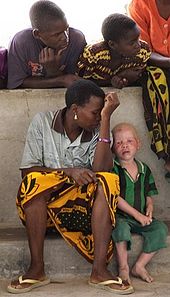 A black woman and her albino son from Tanzania
A black woman and her albino son from Tanzania
Sub-Saharan Africa is a common, if imprecise term that encompasses African countries located south of the Sahara Desert. It is commonly used to differentiate the region culturally, ecologically, politically and, more controversially, racially, from North Africa, which has historically been part of the Mediterranean sphere.
Because the indigenous people of this region are primarily dark-skinned, it is alternatively called "Black Africa".[16] Some criticize the use of the term, because, as it has become in many quarters synonymous with Black Africa, people may not realize that there are also indigenous black populations in North Africa. In addition, the Sahara cuts across countries such as Mauritania, Mali, Niger, Chad, and South Sudan, leaving some parts of them in North Africa and some in sub-Saharan Africa.
Owen 'Alik Shahadah argues that the term sub-Saharan Africa has racist overtones:
Sub-Saharan Africa is a racist byword for "primitive", a place which has escaped advancement. Hence, we see statements like “no written languages exist in Sub-Saharan Africa.” “Ancient Egypt was not a Sub-Saharan African civilization.” Sub-Sahara serves as an exclusion, which moves, jumps and slides around to suit negative generalization of Africa.[17]Some Black Africans prefer to be culturally distinguished from those who live in the north of the continent.[18]
Cultural ideas of a black race
South Africa
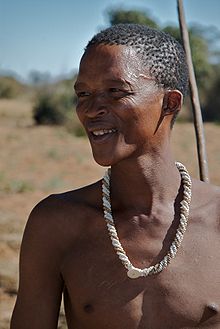 A Khoisan man, an ethnic group in South Africa.
A Khoisan man, an ethnic group in South Africa.
In South Africa during the apartheid era, the population was classified into four main racial groups: Black, White, Asian (mostly Indian), and Coloured. The Coloured group included people of mixed Bantu, Khoisan, and European descent (with some Malay ancestry, especially in the Western Cape). The Coloured definition occupied an intermediary position between the Black and White definitions in South Africa.
The apartheid bureaucracy devised complex (and often arbitrary) criteria in the Population Registration Act to determine who belonged in which group. Minor officials administered tests to enforce the classifications. When it was unclear from a person's physical appearance whether a person was to be considered Colored or Black, the "pencil test" was employed. This involved inserting a pencil in a person's hair to determine if the hair was kinky enough for the pencil to get stuck.[19]
During the apartheid era, those classed as 'Coloured' were oppressed and discriminated against. But, they had limited rights and overall had slightly better socioeconomic conditions than those classed as 'Black'.
In the post-apartheid era, the ANC government's laws in support of their affirmative action policies define 'Black' people to include "Africans", "Coloureds" and "Asians". Their affirmative action policies have also favored 'Africans' over 'Coloureds'. Some South Africans categorized as 'African Black' openly state that 'Coloureds' did not suffer as much as they did during apartheid. The popular saying by 'Coloured' South Africans to illustrate their dilemma is:
We were not white enough under apartheid, and we are not black enough under the ANC (African National Congress)In 2008, the High Court in South Africa ruled that Chinese South Africans who were residents during the apartheid era (and their descendents) are to be reclassified as "Black people" solely for the purposes of accessing affirmative action benefits, because they were also "disadvantaged" by racial discrimination. Chinese people who arrived in the country after the end of apartheid do not qualify.[20]
Other than by appearance, 'Coloureds' can usually be distinguished from 'Blacks' by language. Most speak Afrikaans or English as a first language, as opposed to Bantu languages such as Zulu or Xhosa. They also tend to have more European-sounding names than Bantu names.[21]
In the Middle East
Arab world
See also: Afro-ArabBlack African and Near Eastern peoples have interacted since prehistoric times.[22][23] Some historians estimate that as many as 14 million black slaves were transported across the Red Sea, Indian Ocean, and Sahara Desert in the Arab slave trade from 650 to 1900 CE.[24][25] The Moroccan Sultan Moulay Ismail "the Bloodthirsty" (1672–1727) raised a corps of 150,000 black slaves, called his Black Guard, who coerced the country into submission.[26][27]
In more recent times, about 1000 CE, interactions between black people and Arabs resulted in the incorporation of extensive Arabic vocabulary into Swahili, which became a useful lingua franca for merchants. Some of this linguistic exchange occurred as part of the slave trade; the history of Islam and slavery shows that the major juristic schools traditionally accepted the institution of slavery.[29] As a result, Arab influence spread along the east coast of Africa and to some extent into the interior (see Swahili people). Timbuktu was a trading outpost that linked West Africa with Berber, Arab, and Jewish traders throughout the Arab World. As a result of these interactions, some female-mediated gene flow into the Middle East from Sub-Saharan Africa can be observed in certain populations.[30]
According to Dr. Carlos Moore, resident scholar at Brazil's University of the state of Bahia, Afro-multiracials in the Arab world self-identify in ways that resemble Latin America. He claims that black-looking Arabs, much like black-looking Latin Americans, consider themselves white because they have some distant white ancestry.[31]
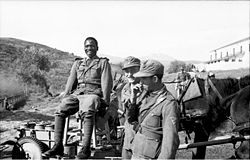 Soldiers of the Free Arabian Legion in Greece, September 1943.
Soldiers of the Free Arabian Legion in Greece, September 1943.
Moore also claims that a film about Egyptian President Anwar Sadat had to be canceled when Sadat discovered that an African-American had been cast to play him. In fact, the 1983 television movie Sadat, starring Louis Gossett, Jr., was not canceled. The Egyptian government refused to let the drama air in Egypt, partially on the grounds of the casting of Gossett.[32]
Sadat's mother was a dark-skinned Sudanese woman and his father was a lighter-skinned Egyptian. In response to an advertisement for an acting position he remarked, "I am not white but I am not exactly black either. My blackness is tending to reddish".[33]
Fathia Nkrumah was another Egyptian with ties to Black Africa. She was the late wife of Ghanaian revolutionary Kwame Nkrumah, whose marriage was seen as helping plant the seeds of cooperation between Egypt and other African countries as they struggled for independence from European colonization. This helped advance the formation of the African Union.[34]
Because of the patriarchal nature of Arab society, Arab men enslaved more black women than men, and used more black female slaves than males. The men interpreted the Qur'an to permit sexual relations between a male master and his female slave outside of marriage,[35][36], leading to many mixed-race children. When an enslaved woman became pregnant with her Arab master's child, she became umm walad or “mother of a child”, a status that granted her privileged rights. The child was allowed to prosper from the wealth of the father and was given rights of inheritance.[37] Because the society was patrilineal, the children took their fathers' status at birth and were born free. Some succeeded their fathers as rulers, as was the case with Sultan Ahmad al-Mansur, who ruled Morocco from 1578 to 1608. His mother was a Fulani concubine of his father.
Such tolerance, however, was not extended to wholly black persons, even when technically "free." Arabs commonly believed that blacks were slaves.[38] The term "abd", (Arabic: عبد,) "slave," remains a common term for black people in the Middle East, often though not always derogatory.[39]
Turkey
See also: Afro-TurksBeginning several centuries ago, a number of sub-Saharan Africans were brought by slave traders during the Ottoman Empire to plantations between Antalya and Istanbul in modern-day Turkey.[40] Some of their descendants remain, mixed with the rest of the population in these areas, and many migrated to larger cities. Some came from the island of Crete following the population exchange between Greece and Turkey in 1923.[41]
Israel
About 150,000 black people live in Israel, amounting to just over 2% of the nation's population. The vast majority of these, some 120,000, are Beta Israel,[42] most of whom came during the 1980s and 1990s from Ethiopia.[43] In addition, Israel is home to over 5,000 members of the African Hebrew Israelites of Jerusalem movement, who reside mainly in a distinct neighborhood in the Negev town of Dimona. Unknown numbers of black converts to Judaism reside in Israel, most of them converts from the UK, Canada, and the United States. Thousands of mixed-race individuals with non-black Jewish relatives also live in Israel.
In the Americas
See also: Afro-American peoples of the AmericasApproximately 12 million Africans were shipped to the Americas during the Atlantic slave trade from 1492 to 1888. Today their descendants number approximately 150 million,[44] most of whom live in the United States, the Caribbean and Latin America, including Brazil. Many have a multiracial background of African, Amerindian, European and Asian ancestry. The various regions developed complex social conventions with which their multi-ethnic populations were classified.
United States
Main article: African AmericanIn the first 200 years that black people were in the United States, they commonly referred to themselves as Africans. In Africa, people primarily identified themselves by ethnic group (closely allied to language) and not by skin color. Individuals would be Ashanti, Igbo, Bakongo or Wolof. But when Africans were brought to the Americas, they were forced to give up their ethnic affiliations when they were combined with other groups from Africa. In areas of the Upper South, different ethnic groups were brought together. This is significant as Africans came from a vast geographic region, the West African coastline stretching from Senegal to Angola and in some cases from the south east coast such as Mozambique. A new identity and culture was born that incorporated elements of the various ethnic groups and of European cultural heritage, resulting in fusions such as the Black church and Black English. This new identity was based on African ancestry and slave status rather than any one ethnic group.[17]
In March 1807, Britain, which largely controlled the Atlantic, declared the trans-atlantic slave trade illegal, as did the United States. (The latter prohibition took effect January 1, 1808, the earliest date on which Congress had the power to do so under Article I, Section 9 of the United States Constitution.)
By that time, the majority of black people were U.S.-born, so use of the term "African" became problematic. Though initially a source of pride, many blacks feared the use of African as an identity would be a hindrance to their fight for full citizenship in the US. They also felt that it would give ammunition to those who were advocating repatriating black people back to Africa. In 1835 black leaders called upon black Americans to remove the title of "African" from their institutions and replace it with "Negro" or "Colored American". A few institutions chose to keep their historic names, such as the African Methodist Episcopal Church. "Negro" and "colored" remained the popular terms until the late 1960s.[45]
The term black was used throughout but not frequently as it carried a certain stigma. In his 1963 "I Have a Dream" speech,[46] Martin Luther King, Jr. uses the terms Negro 15 times and black 4 times. Each time he uses black it is in parallel construction with white (for example,, black men and white men).[47]
With the successes of the civil rights movement, a new term was needed to break from the past and help shed the reminders of legalized discrimination. In place of Negro, activists promoted the use of black as standing for racial pride, militancy and power. Some of the turning points included the use of the term "Black Power" by Kwame Toure (Stokely Carmichael) and the release of James Brown's song "Say It Loud - I'm Black and I'm Proud".
 African American Michael Jordan, considered by many the greatest basketball player in history.
African American Michael Jordan, considered by many the greatest basketball player in history.
In 1988 Jesse Jackson urged Americans to use the term African American because the term has a historical cultural base. Since then African American and black have essentially a coequal status. Controversy continues over which term is more appropriate. Some such as Maulana Karenga and Owen Alik Shahadah argue African-American is more appropriate because it accurately articulates geography and historical origin.[17] Others have argued that "Black" is a better term because "African" suggests foreignness, despite the long presence of Black people in the US.[48] Still others believe the term black is inaccurate because African Americans have a variety of skin tones.[citation needed] Surveys show that the majority of Black Americans have no preference for "African American" or "Black,"[49] although they have a slight preference for "Black" in personal settings and "African American" in more formal settings.[50] Increases in the number of immigrants to the United States from Africa, the Caribbean and Latin America have brought up questions about who uses the term African American. The more recent African immigrants may sometimes view themselves, and be viewed, as culturally distinct from native-born people who are descendants of African slaves.[51]
The U.S. census race definitions says a black is a person having origins in any of the black racial groups of Africa. It includes people who indicate their race as "Black, African Am., or Negro," or who provide written entries such as African American, Afro American, Kenyan, Nigerian, or Haitian. However, the Census Bureau notes that these classifications are socio-political constructs and should not be interpreted as scientific or anthropological.[52]
A considerable portion of the U.S. population identified as black also has some Native American or European ancestry. For instance, genetic studies of African American people show an ancestry that is on average 17–18% European.[53]
One drop rule
Since the late nineteenth century, the South used a colloquial term, the one-drop rule, to classify as black any known African ancestry. This practice of hypodescent was not put into law until the early twentieth century.[54] Legally the definition varied from state to state, and was more flexible in the eighteenth and nineteenth centuries before the American Civil War. For instance, Thomas Jefferson held persons who were legally white (less than 25% Black) according to Virginia law at the time, but, because they were born to slave mothers, they were born into slavery, according to the principle of partus sequitur ventrem, which Virginia adopted into law in 1662.
Outside of the US, some other countries have adopted the one-drop rule, but the definition of who is black and the extent to which the one drop "rule" applies varies greatly from country to country.
The one drop rule may have originated as a means of increasing the number of black slaves[55] and been maintained as an attempt to keep the white race pure.[56] One of the results of the one drop rule was uniting the African-American community.[54] Some of the most prominent civil rights activists were multiracial, and advocated equality for all.[citation needed]
Blackness
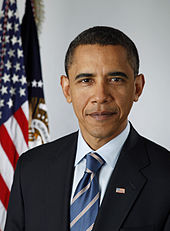 Barack Obama, the first black president of the United States, was throughout his campaign criticized as being either "too black" or "not black enough".[57][58][59]
Barack Obama, the first black president of the United States, was throughout his campaign criticized as being either "too black" or "not black enough".[57][58][59]
The concept of blackness in the United States has been described[by whom?] as the degree to which one associates themselves with mainstream African American culture and values. To a certain extent, this concept is not so much about race but more about culture and behavior. Blackness can be contrasted with "acting white" where black Americans are said to behave with assumed characteristics of stereotypical white Americans, with regard to fashion, dialect, taste in music,[60] and possibly, from the perspective of a significant number of Black youth, academic achievement.[61]
The notion of blackness can also be extended to non-black people. Toni Morrison once described Bill Clinton as the first black president,[62] because of his warm relations with African Americans, his poor upbringing and also because he is a jazz musician. Christopher Hitchens was offended by the notion of Clinton as the first black president noting "we can still define blackness by the following symptoms: alcoholic mothers, under-the-bridge habits...the tendency to sexual predation and shameless perjury about the same".[63] Some black activists were also offended, claiming Clinton used his knowledge of black culture to exploit black people like no other president before[64] for political gain, while not serving black interests. They note his lack of action during the Rwanda genocide[65] and his welfare reform which some claim led to the worst child poverty since the 1960s[66] along with the fact that the number of black people in jail increased during his administration.[67]
The question of blackness also arose in Democrat Barack Obama's 2008 presidential campaign. Commentators have questioned whether Obama, who was elected the first black President of the United States, is black enough, as his mother was white American, and his father was a black Kenyan immigrant.[57][59] Obama refers to himself interchangeably as black and African American.[68]
Brazil
Main article: Race in BrazilThe topic of race in Brazil is a complex and diverse one.[citation needed] A Brazilian child was never automatically identified with the racial type of one or both parents, nor were there only two categories to choose from. Between a pure black and a very light mulatto over a dozen racial categories would be recognized in conformity with the combinations of hair color, hair texture, eye color, and skin color. These types grade into each other like the colors of the spectrum, and no one category stands significantly isolated from the rest. That is, race referred to appearance, not heredity.[69]
There is some disagreement among scholars over the effects of social status on racial classifications in Brazil. It is generally believed that upward mobility and education results in reclassification of individuals into lighter skinned categories. The popular claim is that in Brazil poor whites are considered black and wealthy blacks are considered white. Some scholars disagree arguing that whitening of one's social status may be open to people of mixed race, but a typically black person will consistently be identified as black regardless of wealth or social status.[70][71] Multiracial persons can even reappreciate their African heritage and start to declare themselves as Black persons with increasings of social status and education.
Statistics
Brazilian Population, by Race, from 1872 to 1991 (Census Data)[72] Ethnic group White Black Brown Yellow (Asian) Undeclared Total 1872 3,787,289 1,954,452 4,188,737 - - 9,930,478 1940 26,171,778 6,035,869 8,744,365 242,320 41,983 41,236,315 1991 75,704,927 7,335,136 62,316,064 630,656 534,878 146,521,661 Demographics of Brazil Year White Pardo Black 1835 24.4% 18.2% 51.4% 2000 53.7% 38.5% 6.2% 2010 48.4% 42.4% 6.7% From the year 1500 to 1850 an estimated 3.5 million Africans were forcibly shipped to Brazil.[70] It is estimated that more than half of the Brazilian population is at least in part descendants of these Africans. Brazil has the largest population of Afro-descendants outside of Africa. In contrast to the US there were no segregation or anti-miscegenation laws in Brazil and as a result intermarriage has affected a large majority of the Brazilian population. Even much of the white/Asian population has either African or Amerindian blood. According to the last census of the 20th century 54% identified themselves as white, 6.2% identified themselves as black and 39.5% identified themselves as Pardo (brown) — a broad multiracial category.[73]
A philosophy of whitening emerged in Brazil in the 19th century. Until recently the government did not keep data on race. However, statisticians estimate that in 1835 half the population was black, one fifth was Pardo (brown) and one fourth white. By 2000 the black population had fallen to only 6.2% and the Pardo had increased to 40% and white to 55%. Essentially most of the black population was absorbed into the multiracial category by intermixing.[69] A recent study found that at least 29% of the middle class white Brazilian population had some recent African ancestry.[74]
Race relations in Brazil
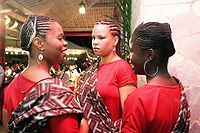 Afro-Brazilian women during a Candomblé ceremony.
Afro-Brazilian women during a Candomblé ceremony.
Because of the ideology of miscegenation, Brazil has avoided the polarization of society into black and white. The bitter and sometimes violent racial tensions that divide the US are notably absent in Brazil. According to the census, 6.7% of Brazilians said they were black, compared with 6.2% in 2000, and 43.1% said they were mixed race, up from 38.5%. According to Brazil's minister for racial equality, Elio Ferreira de Araujo, attributed the change to growing pride among his country's black and indigenous communities.[75]
However, the philosophy of the racial democracy in Brazil has drawn criticism from some quarters. Brazil has one of the largest gaps in income distribution in the world. The richest 10% of the population earn 28 times the average income of the bottom 40%. The richest 10 percent is almost exclusively white. One-third of the population lives under the poverty line, with blacks and other non-whites accounting for 70 percent of the poor.[76]
In the US, black people earn 75% of what white people earn.[77] In Brazil, non-whites earn less than 50% of what whites earn. Some have posited that Brazil does in fact practice the one drop rule when social economic factors are considered. This is because the gap in income between blacks and other non-whites is relatively small compared to the large gap between whites and non-whites. Other factors such as illiteracy and education level show the same patterns.[78] Unlike in the US where African Americans were united in the civil rights struggle, in Brazil the philosophy of whitening has helped divide blacks from other non-whites and prevented a more active civil rights movement.
Though Brazilians of African heritage make up a large percentage [79] the population there are very few black politicians. The city of Salvador, Bahia for instance is 80% Afro-Brazilian but has never had a black mayor. Critics indicate that US cities that have a black majority, such as Detroit and New Orleans, have never had white mayors since first electing black mayors in the 1970s.[80][81]
Non-white people also have limited media visibility. The Latin American media, in particular the Brazilian media, has been accused of hiding its Black, Indigenous, Multiracial and East Asian population. For example the telenovelas or soaps are said to be a hotbed of largely light-eyed white and light-skinned mulattoes and mestizos (often deemed as white persons in Brazil if achieving the middle class or higher social status) actors. Most rare empowered persons of color represented in Latin American media possess typically Caucasian features due to a mix of racist standards of beauty, colourism and lookism. Nevertheless, in the last years, the number of empowered afrodescendants (either economically or by other ways) increased in Brazilian media coverage. Despite Brazil also possessing criminal black man stereotypes, it is considered a huge prejudice and mostly not used in a disordered way by the media, in spite of sometimes common "humouristic" sexist jokes and LGBT stereotyping [82] and as such lack of politically correctness in native race issues is not a major problem (there are way more stereotypes of Asian people, Europeans or U.S. Americans, for example).
These patterns of discrimination against non-whites have led some to advocate for the use of the Portuguese term 'negro' to encompass non-whites so as to renew a black consciousness and identity, in effect an African descent rule.[83] It generates criticism since Pardo, or Brown people, is intended to include caboclos (mestizos), assimilated Amerindians and tri-racials, not only afrodescendants — thus Brazilian of some or no recent African descent, as most White Brazilians, become 60–70% of the population, breaking the argument of possible Brazilian one drop rule since real noticeable mulattoes, cafuzos (zambos) and black persons are a minority and the Brazilian poor represents larger percents in Brazil. As one would expect from an underdeveloped country, there are pockets of poverty in White-majority and Japanese Brazilian-majority areas, rarer in urban developments but common in rural areas. They are even more common among Mestizo-majority areas, and Amerindian communities.
In Asia and Australasia
China
As of August, 2008, The Migration Information Source article noted that "A Nigerian Embassy spokesman estimated that Nigerians possibly make up the largest group of Black Africans in China, with about 2,000 to 3,000 Nigerians in Guangdong in 2006. Most businessmen only stay temporarily."[84][85]
 An ethnic Ati woman of the Philippines. The Negritos were the earliest inhabitants of Southeast Asia.
An ethnic Ati woman of the Philippines. The Negritos were the earliest inhabitants of Southeast Asia.
India and Southeast Asia
See also: Indo-African (disambiguation)The Great Andamanese are one of five Afro Asian ethnic groups (Adivasi or tribal) native to the Andaman and Nicobar Islands; they are among the first inhabitants of what is now India, arriving over 70,000 years ago. They are facing extinction.[86] The other four ethnic groups are the Jangil, Jarawa, Onge and Sentinelese. By their external physical appearance (phenotype) such people resemble Black Africans with dark skin and sometimes tightly coiled hair. There have been suggestions of a Black African origin. However, in the case of the Andamanese people, a study conducted by the NCBI indicated that the Andamanese people possessed closer affinities with the Southeast Asian population than with the Black African population.[87]
In South India there are also several communities of Black African descent, such as the Sheedis/Siddis, specifically the Siddis of Karnataka, who descend from Zanj (Black African) slaves. In Pakistan, Zanj descendants are known as the Makrani.
Other black people of Southeast Asia, collectively known as Negritos, include the Semang peoples of Malaysia, the Mani of Thailand the Aeta of Luzon and the Ati of Panay in the Philippines.[88]
Melanesia
There are several groups of dark-skinned people who live in various parts of Asia, Australia and Oceania who sometimes are referred to as black people. They include the Indigenous Australians, the Melanesians (now divided into Austronesian-speaking populations and Papuans, and including the great genetic diversity of New Guinea), the Semang people of the Malay peninsula, and indigenous first nation Fijians. They are as genetically, anthropologically and culturally related to Africans as all other non-Africans, and because of this is controversial to label them black people in the sense of some relation to the native African peoples and the African diaspora.
In Europe
Main article: Black people in EuropeUnited Kingdom
Main article: Black BritishSee also: Black British population, British African-Caribbean community, and Black ScottishAccording to the Office for National Statistics, as of the 2001 census, there are over a million black people in the United Kingdom; 1% of the total population describe themselves as "Black Caribbean", 0.8% as "Black African", and 0.2% as "Black other".[89] Britain encouraged the immigration of workers from the Caribbean after World War II; the first symbolic movement was those who came on the ship the Empire Windrush. The preferred official umbrella term is "black and minority ethnic" (BME), but sometimes the term "black" is used on its own, to express unified opposition to racism, as in the Southall Black Sisters, which started with a mainly British Asian constituency.
France
Main article: Afro-FrenchFrance is an ethnically diverse nation, with about 2.5 – 5 million black people.[90][91]
Balkans
Due to the Ottoman slave trade that had flourished in the Balkans, the coastal town of Ulcinj in Montenegro had its own black community.[92] As a consequence of the slave trade and privateer activity, a considerable number of Ulcinj inhabitants until 1878 were black.[93] The Ottoman Army also sent an estimated 30,000 Black African troops and cavalrymen to its expedition in Hungary during the Austro-Turkish War of 1716–18.[94]
Eastern Europe
As African states became independent in the 1960s, the Soviet Union offered many of their citizens the chance to study in Russia. Over a period of 40 years, about 400,000 African students from various countries moved to Russia to pursue higher studies, including many Black Africans.[95][96] This extended beyond the Soviet Union to many countries of the Eastern bloc.
Debates on race
In Afrocentrism
Main articles: Afrocentrism and Ancient Egyptian race controversyA controversy over the skin color and ethnic origins of the ancient Egyptians was sparked as part of the Afrocentric debate.[97] Afrocentrist scholars such as Cheikh Anta Diop contend that ancient Egypt was primarily a "black civilization". One source cited in support of their argument is Herodotus, who wrote around 450 B.C. that "Colchians, Ethiopians and Egyptians have thick lips, broad nose, woolly hair and they are burnt of skin."[98] However, Classical scholar Frank Snowden, Jr. cautions against the reliance on accounts by ancient writers to describe the physical characteristics of other ancient peoples, as they held different connotations from those of modern-day terminology in the West. He also points out that other ancient writers clearly distinguished between Egyptians and Ethiopians.[99]
Keita and Boyce confront this issue in a 1996 article entitled, "The Geographical Origins and Population Relationships of Early Ancient Egyptians". As anthropologists, they point out the danger in relying on ancient interpretation to reveal for us the biological make up of a population. In any case they contend, the relevant data indicates greater similarity between Egyptians and Ethiopians than the former group with the Ancient Greeks.[100]
Ancient Egyptians are often portrayed in modern media as Caucasians. Afrocentrists, in particular, have been critical of this.[101] According to Egyptologists, ancient Egypt was a multicultural society of Middle Eastern, Northeast African, and Saharan influences.[97][102] Afrocentrists argue that anthropological and archaeological evidence shows that what they term an Africoid element was evident in ancient Egypt,[103] which they argue was predominant in Abydos in the First dynasty of Egypt.[104][105]
See also
- African-American
- African diaspora
- African Jews
- Afro-Europeans
- Afro-Asian
- Afro Asians (African Asians)
- Afro-Latino
- Afro-Trinbagonian
- Creole peoples
- List of topics related to the Black Diaspora
- Mulatto
- Negritos
- Stereotypes of black people
- Sub-Saharan Africa
- The Minds of Marginalized Black Men (book)
Footnotes
- ^ McPherson, Lionel K; Shelby, Tommie (2008). Blackness and Blood: Interpreting African American Identity. John Wiley & Sons, Inc. p. 179. http://www.blackwellpublishing.com/content/BPL_Images/Journal_Samples/PAPA0048-3915~32~2~10%5C010.pdf.
- ^ Glenn, Evelyn Nakano (2009). Shades of difference: why skin color matters. Stanford University Press. p. 225. ISBN 9780804759984. http://books.google.ca/books?id=WewhspE2Q9UC&lpg=PR1&dq=Shades%20of%20difference%3A%20why%20skin%20color%20matters&pg=PA225#v=onepage&q&f=true
- ^ Human skin color diversity is highest or sub-Saharan African populations. NIH.gov
- ^ Various isolated populations in Southeast Asia sometimes classified as black include the Austronesians and Papuans, the Andamanese islanders, the Semang people of the Malay peninsula, the Aeta people of Luzon, and some other small populations of indigenous peoples.
- ^ black. (n.d.). Dictionary.com Unabridged (v 1.1). Retrieved April 13, 2007, from Dictionary.com website
- ^ Rogers, Alan R.; Iltis, David; Wooding, Stephen (February 2004). "Genetic variation at the MC1R locus and the time since loss of human body hair". Current Anthropology (The Wenner-Gren Foundation for Anthropological Research) 45 (1): 105–8. doi:10.1086/381006. OCLC 193553649. http://www.journals.uchicago.edu/doi/abs/10.1086/381006. Retrieved 2008-07-22.
- ^ Nouri, Keyvan (2007). Skin Cancer. McGraw-Hill Professional. p. 32. ISBN 0-071-47256-8. http://books.google.com/?id=TlhFQYziim8C&pg=PA32.
- ^ Edlin, Gordon; Golanty, Eric (312). Health and Wellness. Jones & Bartlett Learning. ISBN 0-763-76593-7. http://books.google.com/?id=Ki_fbxDZsHcC&pg=PA312.
- ^ "Australia Struggles with Skin Cancer". http://www.cancer.org/docroot/NWS/content/NWS_1_1x_Australia_Struggles_with_Skin_Cancer.asp.
- ^ "Scientists find DNA change accounting for white skin". Washington Post.
- ^ Franbourg et al. "Influence of Ethnic Origin of Hair on Water-Keratin Interaction" In Ethnic Skin and Hair E. Berardesca, J. Leveque, and H. Maibach (Eds.). page 101. Informa Healthcare. 2007
- ^ a b Nick Arrojo, Jenny Acheson, Great Hair: Secrets to Looking Fabulous and Feeling Beautiful Every Day, (St. Martin's Press: 2008), p.184
- ^ a b Dale H. Johnson, Hair and hair care, (CRC Press: 1997), p.237
- ^ Ethnic Skin and Hair E. Berardesca, J. Leveque, and H. Maibach (Eds.). Informa Healthcare. 2007
- ^ Iyengar, B. "The hair follicle is a specialized UV receptor in human skin?" Bio Signals Recep, 7(3), pages 188–194. 1998[not in citation given]
- ^ Keita, Lansana (2004). "Race, Identity and Africanity: A Reply to Eboussi Boulaga". CODESRIA Bulletin (Council for the Development of Social Science Research in Africa) 1 & 2: 16.
- ^ a b c Shahadah, Owen 'Alik. "Linguistics for a new African reality". http://www.africanholocaust.net/news_ah/language%20new%20reality.htm.
- ^ Keith B., Richburg (Reprint edition (July 1, 1998)). Out of America: A Black Man Confronts Africa. Harvest/HBJ Book. ISBN 0156005832.
- ^ Nullis, Clare (2007). "Township tourism booming in South Africa". The Associated Press. http://www.canada.com/topics/travel/features/story.html?id=59ec6285-c9fb-41ab-93f9-419f62733f07&k=67896.
- ^ "We agree that you are black, South African court tells Chinese", The Times
- ^ du Preez, Max (2006-04-13). "Coloureds – the most authentic SA citizens". The Star. http://www.thestar.co.za/index.php?fArticleId=3201857.
- ^ "Mauritania: Fair elections haunted by racial imbalance"
- ^ Remembering East African slave raids
- ^ "The Unknown Slavery: In the Muslim world, that is – and it's not over"
- ^ Welcome to Encyclopædia Britannica's Guide to Black History
- ^ Lewis. Race and Slavery in the Middle East. Oxford Univ Press 1994.
- ^ ʿAbīd al-Bukhārī (Moroccan military organization). Encyclopædia Britannica.
- ^ "Slaves in Saudi". Naeem Mohaiemen. The Daily Star, 27 July 2004.
- ^ Lewis 1994, Ch.1
- ^ "Extensive Female-Mediated Gene Flow from Sub-Saharan Africa into Near Eastern Arab Populations", National Institutes of Health
- ^ Musselman, Anson. "The Subtle Racism of Latin America". UCLA International Institute. http://www.international.ucla.edu/article.asp?parentid=4125.
- ^ Louis Gosset Jr. Hollywood.com
- ^ Joseph Finklestone, Anwar Sadat: Visionary Who Dared, pages 5–7,31 ISBN 0-7146-3487-5
- ^ African Union Summit
- ^ See Tahfeem ul Qur'an by Sayyid Abul Ala Maududi, Vol. 2 pp. 112–113 footnote 44; Also see commentary on verses [Quran 23:1]: Vol. 3, notes 7–1, p. 241; 2000, Islamic Publications
- ^ Tafsir ibn Kathir 4:24
- ^ "Slavery in Arabia". "Owen 'Alik Shahadah". http://www.arabslavetrade.com.
- ^ Hunwick, John. "Arab Views of Black Africans and Slavery" (PDF). http://www.yale.edu/glc/events/race/Hunwick.pdf.
- ^ Labbé, Theola; Omar Fekeiki (2004-01-11). "A Legacy Hidden in Plain Sight". Washington Post. http://www.washingtonpost.com/ac2/wp-dyn?pagename=article&contentId=A6645-2004Jan10. Retrieved 2008-01-29.
- ^ Ayvalık’ın renkli derneği, retrieved 28 August 2008
- ^ "Turks with African ancestors want their existence to be felt", Today's Zaman, 11 May 2008, Sunday, retrieved 28 August 2008]
- ^ "The Ethiopian Population In Israel", Reuters. July 16, 2009.
- ^ "Why Jews see racism in Israel", Christian Science Monitor, September 1, 2009.
- ^ "Community Outreach" Seminar on Planning Process for SANTIAGO +5 , Global Afro-Latino and Caribbean Initiative, February 4, 2006
- ^ African American Journeys to Africa page63-64
- ^ Martin Luther King, Jr. (August 28, 1963). I Have a Dream (Google Video). Washington, D.C.. http://video.google.com/videoplay?docid=1732754907698549493.[dead link]
- ^ Smith, Tom W. (Winter, 1992). "Changing Racial Labels: From "Colored" to "Negro" to "Black" to "African American"" (PDF). The Public Opinion Quarterly (Oxford University Press) 56 (4): 496–514. doi:10.1086/269339. OCLC 192150485. http://www.soc.iastate.edu/soc522a/PDF%20readings/Smith.pdf.
- ^ McWhorter, John H. (8 September 2004). "Why I'm Black, Not African American". Los Angeles Times. http://www.manhattan-institute.org/html/_latimes-why_im_black.htm. Retrieved 26 September 2010.
- ^ Newport, Frank (28 September 2007). "Black or African American?". Gallup. http://www.gallup.com/poll/28816/black-african-american.aspx. Retrieved 26 September 2010.
- ^ Miller, Pepper; Kemp, Herb (2006). What's Black About? Insights to Increase Your Share of a Changing African-American Market. Paramount Market Publishing, Inc. p. 8. ISBN 0972529098. OCLC 61694280. http://books.google.com/books?id=1OzZr_U2x_wC&lpg=PP1&pg=PA8#v=onepage&q&f=false.
- ^ Swarns, Rachel L. (2004-08-29). "'African American' Becomes a Term for Debate". The New York Times. http://query.nytimes.com/gst/fullpage.html?res=990CE5DB1F3EF93AA1575BC0A9629C8B63. Retrieved 2008-07-22.
- ^ 2000 US Census basics
- ^ How White Are Blacks? How Black Are Whites? by Steve Sailer
- ^ a b James, F. Davis. "Who is Black? One Nation's Definition". PBS. http://www.pbs.org/wgbh/pages/frontline/shows/jefferson/mixed/onedrop.html.
- ^ Clarence Page, A Credit to His Races, The NewsHour with Jim Lehrer, May 1, 1997.
- ^ Sweet, Frank (2006-04-01). "Presenting the Triumph of the One-Drop Rule". The One-Drop Rule. http://backintyme.com/essays/?p=25. Retrieved 2008-07-22.
- ^ a b "Remarks of Senator Barack Obama: 'A More Perfect Union' (transcript)" (pdf). BBC News. 2008-03-18. pp. p2. http://news.bbc.co.uk/1/shared/bsp/hi/pdfs/18_03_08_obama_speech.pdf. Retrieved 2008-06-27. "This is not to say that race has not been an issue in the campaign. At various stages in the campaign, some commentators have deemed me either "too black" or "not black enough." We saw racial tensions bubble to the surface during the week before the South Carolina primary. The press has scoured every exit poll for the latest evidence of racial polarization, not just in terms of white and black, but black and brown as well." See also: video
- ^ Adesioye, Lola (2008-06-27). "Too black or not black enough, Obama just can't win". Comment is Free (London). http://www.guardian.co.uk/commentisfree/2008/jun/27/barackobama.ralphnader?gusrc=rss&feed=commentisfree. Retrieved 2008-06-27.
- ^ a b Coates, Ta-Nehisi Paul (2007-02-01). "Is Obama Black Enough?". Time. http://www.time.com/time/nation/article/0,8599,1584736,00.html. Retrieved 2008-06-27. "Barack Obama's real problem isn't that he's too white — it's that he's too black."
- ^ Edler, Melissa (Spring 2007). "Acting White". Kent State Magazine. http://www.kent.edu/Magazine/Spring2007/ActingWhite.cfm. Retrieved 2008-07-22.
- ^ Ogbu, J. "Black American students in an affluent suburb: a study of academic disengagement". Erlbaum Associates Press. Mahwah, NJ. 2003.
- ^ Hansen, Suzy (2002-02-20). "Blacks and Bill Clinton". Salon. http://dir.salon.com/story/books/int/2002/02/20/clinton/index.html. Retrieved 2008-07-22.
- ^ No One Left to Lie to by Christopher Hitchens, 1999, pg 47
- ^ "Find Articles 404 File not found". http://findarticles.com/p/articles/mi_go1637/is_200204/ai_n6880693.[dead link]
- ^ Carroll, Rory (2004-03-31). "US chose to ignore Rwandan genocide". The Guardian (London). http://www.guardian.co.uk/world/2004/mar/31/usa.rwanda. Retrieved 2008-07-22.
- ^ Roberts, Larry (1999-06-02). "Clinton's welfare reform has increased child poverty". World Socialist Web Site. http://www.wsws.org/articles/1999/jun1999/welf-j02.shtml. Retrieved 2008-07-22.
- ^ Gray, Kevin A. (2002-12-07). "Soul Brother? Clinton and Black Americans". Counterpunch. http://www.counterpunch.org/gray1207.html. Retrieved 2008-07-22.
- ^ Kroft, Steve (2007-02-11). "A Transcript Excerpt Of Steve Kroft’s Interview With Sen. Obama". CBS News. http://www.cbsnews.com/stories/2007/02/11/60minutes/main2458530.shtml. Retrieved 2008-07-22.
- ^ a b Skidmore, Thomas E. (April 1992). "Fact and Myth: Discovering a Racial Problem in Brazil" (PDF). Working Paper 173. http://www.nd.edu/~kellogg/publications/workingpapers/WPS/173.pdf.
- ^ a b Edward E., Telles (2004). Race in Another America: The Significance of Skin Color in Brazil. Princeton University Press. pp. 95–98. ISBN 0691118663.
- ^ Telles, Edward E. (3 May 2002). "Racial Ambiguity Among the Brazilian Population" (PDF). Ethnic and Racial Studies (California Center for Population Research) 25 (3): 415–441. doi:10.1080/01419870252932133. http://www.ccpr.ucla.edu/ccprwpseries/ccpr_012_01.pdf.
- ^ http://www.ibge.gov.br/ibgeteen/povoamento/
- ^ "CIA World Factbook: Brazil". https://www.cia.gov/library/publications/the-world-factbook/geos/br.html.[dead link]
- ^ Sex-biased gene flow in African Americans but not in American Caucasians
- ^ http://www.guardian.co.uk/world/2010/aug/25/brazil-2010-census-kalunga Guardian | Brazil's census offers recognition at last to descendants of runaway slaves
- ^ Barrolle, Melvin Kadiri. "African 'Americans' in Brazil". New America Media. http://news.newamericamedia.org/news/view_article.html?article_id=5b8d531de860940110af2433244782c6. Retrieved 2009-08-05.
- ^ http://www.guardian.co.uk/world/2011/nov/17/brazil-census-african-brazilians-majority Guardian Newspaper | Brazil census shows African-Brazilians in the majority for the first time
- ^ Roland, Edna Maria Santos. "The Economics of Racism: People of African Descent in Brazil". http://www.falapreta.org.br/durban/racism.doc.
- ^ http://www.guardian.co.uk/world/2011/nov/17/brazil-census-african-brazilians-majority Guardian | Brazil's census offers recognition at last to descendants of runaway slaves
- ^ Charles Whitaker, "Blacks in Brazil: The Myth and the Reality," Ebony, February 1991
- ^ http://www.guardian.co.uk/world/2010/aug/25/brazil-2010-census-kalunga Guardian | Brazil's census offers recognition at last to descendants of runaway slaves
- ^ (Portuguese) Vexing stereotypes in humouristic shows is homophobia, lawyer Maria Berenice says. Maria Berenice Dias "homoaffective" (LGBT) rights, Family Law and Succession lawyer blog, 2011.
- ^ Brazil Separates Into a World of Black and White, Los Angeles Times, September 3, 2006
- ^ China and Africa: Stronger Economic Ties Mean More Migration. By Malia Politzer. Migration Information Source. August 2008
- ^ Guangzhou "Chocolate City": Africans Seek Their Dreams in China. 18-Dec-2008.
- ^ Extinction threat for Andaman natives. BBC News. March 5, 2005.
- ^ Thangaraj, Kumarasamy; Singh, L; Reddy, AG; Rao, VR; Sehgal, SC; Underhill, PA; Pierson, M; Frame, IG et al. (2003-01-21). "Genetic Affinities of the Andaman Islanders, a Vanishing Human Population" (PDF). Current Biology 13 (2): 86–93. doi:10.1016/S0960-9822(02)01336-2. OCLC 112009350. PMID 12546781. http://hpgl.stanford.edu/publications/CB_2002_p1-18.pdf. Retrieved 2009-08-05.
- ^ Chapter 6: The Negrito Race
- ^ National Statistics Online
- ^ Europe's Minority Politicians in Short Supply. The Washington Post. April 24, 2005.
- ^ In officially colorblind France, blacks have a dream – and now a lobby. Csmonitor.com. January 12, 2007.
- ^ Yugoslavia – Montenegro and Kosovo – The Next Conflict?
- ^ ULCINJ – HISTORY
- ^ African Slave Trade in Russia, By Dieudonne Gnammankou in La Channe et le lien, Doudou Diene, (id.) Paris, Editions UNESCO, 1988
- ^ MediaRights: Film: Black Russians
- ^ Лили Голден и Лили Диксон. Телепроект "Черные русские": синопсис. Info on "Black Russians" film project in English
- ^ a b Building bridges to Afrocentrism
- ^ "Huge Ancient Egyptian Photo Gallery". http://www.freemaninstitute.com/RTGhistory.htm.
- ^ Snowden, Jr., Frank M. (1996). Mary R. Lefkowitz and Guy MacLean Rogers (eds.). ed. Black Athena Revisited. Chapel Hill: University of North Carolina Press. pp. 113–14. "....the Afrocentrists are mistaken in assuming that the terms Afri (Africans) and various color adjectives for dark pigmentation as used by Greeks and Romans are always the classical equivalents of Negores or blacks in modern usage.... That the pigmentation of the Egyptians was seen as lighter than that of Ethiopians is also attested by the adjective subfusucli ("somewhat dark") which Ammianus Marcellinus (22.16.23) chose to describe the Egyptians...."
- ^ Keita, Boyce, Shomarka, A.J. (1996). Theodore Celenko(ed). ed. Egypt in Africa. Chapel Hill: Indianapolis Museum of Art. pp. 25–27. "....The descriptions and terms of ancient Greek writers have sometimes been used to comment on Egyptian origins. This is problematic since the ancient writers were not doing population biology. However, we can examine one issue. The Greeks called all groups south of Egypt "Ethiopians". Were the Egyptians more related to any of these "Ethiopians" than to the Greeks? As noted, cranial and limb studies have indicated greater similarity to Somalis, Kushites and Nubians, all "Ethiopians" in ancient Greek terms....."
- ^ "The Identity Of Ancient" (PDF). http://www.calumet.purdue.edu/mcnair/cynthia_research.pdf.
- ^ Were the Ancient Egyptians black or white
- ^ Basil Davidson. The Nile. http://www.lincoln.edu/history/his307/davidson/1/dif3.wmv.
- ^ Studies and Comments on Ancient Egyptian Biological Relationships, by S.O.Y. Keita, History in Africa, 20: 129–154 (1993)
- ^ Keita, S.O.Y. (March 1992). "Further studies of crania from ancient northern Africa: an analysis of crania from First Dynasty Egyptian tombs". American Journal of Physical Anthropology 87 (3): 245–254. doi:10.1002/ajpa.1330870302. PMID 1562056. http://www3.interscience.wiley.com/cgi-bin/abstract/110482899/ABSTRACT?CRETRY=1&SRETRY=0. Retrieved 2007-09-23. "The predominant craniometric pattern in the Abydos [First Dynasty] royal tombs is "southern" (tropical African variant)... However, lower Egyptian, Maghrebian, and European patterns are observed also, thus making for great diversity... The centroid values of the various upper Egyptian series viewed collectively are seen to vary over time. The general trend from Badari to Nakada times, and then from the Nakadan to the First Dynasty epochs demonstrate change toward the northern-Egyptian centroid value on Function I with similar values on Function 11. This might represent an average change from an Africoid (Keita, 1990) to a northern-Egyptian-Maghreb modal pattern.... This northern modal pattern, which can be called coastal northern African, is noted in general terms to be intermediate, by the centroid scores of Function I, to equatorial African and northern European phenotypes."[dead link]
Historical definitions of race Color terminology for race Typological definitions of race Typological sub-types Alpine race · American Indian race · Arabid race · Armenoid race · Aryan race · Balkans-Caucasian race · Bantu race · Caspian race · Dinaric race · East Baltic race · Ethiopid race · Hamitic race · Dravidian race · Iranid race · Malay race · Mediterranean race · Nilotic race · Nordic race · Northcaucasian race · Pamirid race · Pontid race · Semitic race · Sudanic raceMixed races Related concepts Writers John Baker · Johann Friedrich Blumenbach · Houston Stewart Chamberlain · Carleton S. Coon · Joseph Deniker · Egon Freiherr von Eickstedt · Arthur de Gobineau · Madison Grant · Hans F. K. Günther · Georges Vacher de Lapouge · Bertil Lundman · Felix von Luschan · William Z. Ripley · Ilse Schwidetzky · Giuseppe Sergi · Lothrop StoddardWritings Categories:- Black African people
- Latin American caste system
- Race
Wikimedia Foundation. 2010.


